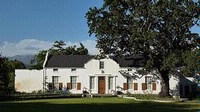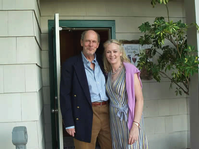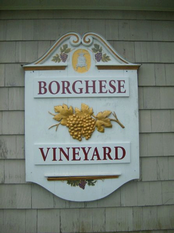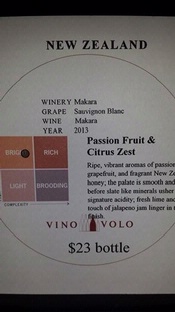|
|
 |
|
July 22, 2014
Figuring out what the average American wine consumer wants is no more challenging than walking into Trader Joe's or Costco and spending a few minutes in the wine department.
Wines from Chile and Argentina are prominent. Both countries are well-represented in the American wine market for good reason: Both are universally respected for the quality of their wines at reasonable prices.
 Yet this tried and true business model doesn't work, or hasn't worked, for everyone. The most glaring example is South Africa, which has been a serious wine-producing nation for at least three centuries. Yet this tried and true business model doesn't work, or hasn't worked, for everyone. The most glaring example is South Africa, which has been a serious wine-producing nation for at least three centuries.
The wines of South Africa can be very, very good and are generally very, very cheap, owing to a currency exchange rate of 10 U.S. dollars for one South African rand. It would stand to reason, then, that South African wines would be every bit as attractive to the average American consumer as the wines of Chile and Argentina.
Yet that is not the case, a condition that longtime South African winemaker Niel Groenewald is at pains to reverse. Hence the chief winemaker for Bellingham Winery, established in 1693, recently made his first trip to the United States to put a genial face on the wines of South Africa.
This is an important step, it seems, because South African wines were shunned somewhat during the era of apartheid. Precious little has been done in the two decades since the end of apartheid to position South African wines to benefit from the sustained wine boom that has seen the United States emerge as the largest wine market in the world.
If South African wine is known for anything, it is typically the frequently disparaged red wine known as pinotage, made from a grape variety that is a cross between pinot noir and cinsault (which at one time was called hermitage in South Africa).
I am no fan, but had to concede the 2011 Bellingham "Bush Vine" pinotage ($30) Groenewald presented at lunch recently was a world class red, a meaty, smoky, firmly structured, complex wine that could stand as a benchmark for pinotage of a certain ilk.
"Because pinotage was a relatively new grape variety and only planted widely in the 1950s, there was no clear style that dictated what pinotage should be," he explained. "Stylistically it was all over the map."
The Groenewald expression of pinotage is clearly an attempt at classically structured red wine that will improve in the bottle for a decade or more.
"The best pinotage ages very well, even better than cabernet sauvignon in South Africa," he said.
The overall impression left by the Bellingham wines, including the independent brand Boschendal (established 1685), was positive. The wines are clean and well-balanced, with an emphasis on freshness. Chenin blanc is perhaps South Africa's signature white wine, and the chenins of South Africa may well be the best chenins in the world outside of France.
But being good and cheap doesn't in and of itself guarantee success in the market.That's why the talented winemaker Groenewald is out on the wine stump spreading the word. It's a small step, but a step nonetheless.
Posted by Robert Whitley at 4:29 PM
|
|
July 16, 2014
I'm often struck by the utter banality of the exhortation, presented as wisdom by many wine professionals, to drink what you like.
In other words, same old same old is just fine. Suggestions that might broaden the palate and open up a world of intriguing tasting experiences are trumped by one's personal comfort zone. You want a buttery Rombauer chardonnay with that rare prime rib, big guy? You have at it.
Of course, that would be sticking with a favorite and comfortable flavor in the extreme, but it is the current conventional wisdom, yes? Well, no.
The drink-what-you-like crowd wants you to be confident in your own taste buds and flavor preferences. The reality, however, is that those personal preferences evolve over time and only after tasting a broad selection of wines that you probably won't like.
I'm not fond of retsina, the white wine from Greece that tastes like Pine Sol. How do I know I don't like it? Bingo. I've tasted enough retsina from the best producers to know that no matter who makes it or what they do to it, it's not my goblet of vino.
I feel almost the same way about pinotage, the eclectic red wine from South Africa. I've tasted one or two that I found palatable, but the vast majority leave me longing for something, almost anything else.
Tannat, the tannic red from the south of France and Uruguay, is another clunker in my book.
You may or may not have the same reaction to these wines, but you will never know until you try. And that's what the DWYLC misses.
For example, during one of my many visits to Northern Italy I fell in love with ribolla gialla, a white wine you will find in Friuli. You won't find a huge selection of this delicious white in the U.S. because most importers who bring in white wine from Friuli focus on pinot grigio.
The reason they do is because everyone is comfortable with pinot grigio. Ribolla gialla not so much. The importers, having been told this over and over again by the drink-what-you-like-crowd, are afraid to bring in any significant quantity of wine that you may not like or don't know that you might like if you would only give it a try.
If you're thinking this is a vicious cycle, you would be correct. So here's my advice: Next time you are at your favorite wine shop, pick up something you've never had before.
If it boasts a recommendation from a credible source, or a medal from a major wine competition, give it a shot. You might not like it. You might even hate it (as in my experiences with retsina).
Then again, you might love it. Unless you try it, you will never know.
Posted by Robert Whitley at 4:25 PM
|
|
July 4, 2014
The New York wine industry is deeply saddened by the recent deaths of Marco and Ann Marie Borghese, owners of Long Island’s Castello di Borghese Vineyard and Winery. Marco  Borghese was killed in a car crash Monday, June 30, a few days after his wife died of cancer. Borghese was killed in a car crash Monday, June 30, a few days after his wife died of cancer.
The couple purchased Castello di Borghese in 1999. Originally called Hargrave Vineyard, the estate was founded in 1973 by Louisa and Alex Hargrave, who launched Long Island’s vinifera wine industry. Marco and Ann Marie Borghese quickly established themselves as members of the New York wine community. Four years after moving to the North Fork he was elected president of the Long Island Wine Council. In 2005 the New York Wine & Grape Foundation awarded Marco Borghese its  Unity Award, the Foundation’s highest honor, in honor of his important role on behalf of both Long Island and the broader statewide wine industry. Unity Award, the Foundation’s highest honor, in honor of his important role on behalf of both Long Island and the broader statewide wine industry.
Marco Borghese, a native of Italy’s Tuscany region, oversaw the vineyards as well as the winemaking at Castello di Borghese. Ann Marie, who was in charge of marketing and promotion, was also involved in some of the winemaking decisions. She established an art gallery at the winery dedicated to showcasing the work of local artists, and was an active participant in many local charity and music events. Reached for comment earlier today, Louisa Hargrave noted that, "Everyone here is completely overwhelmed--it is too hard to even imagine the depth of this tragedy, especially for their children."
Posted by Marguerite Thomas at 4:19 PM
|
|
July 1, 2014
To many an intrepid traveler, the appearance of a Vino Volo during the schlep from airport security to the departure gate is a welcome alternative to the garden-variety airport bar with a small selection of often-insipid wines by the glass.
The Vino Volo wine bars that have started to pop up in airports throughout the nation typically offer a broad selection of red and white wines, wine-friendly snacks and enough ambiance to sooth even the most frazzled frequent flyer.
 As I arrived two hours early at San Francisco International airport on a recent journey, I ducked into this oasis to kill time as I awaited my flight home. I ordered a tasty New Zealand Sauvignon Blanc and settled in. As I arrived two hours early at San Francisco International airport on a recent journey, I ducked into this oasis to kill time as I awaited my flight home. I ordered a tasty New Zealand Sauvignon Blanc and settled in.
When the glass of vino arrived, the server placed it on a paper coaster that also doubled as a promotional piece for the wine I was about to taste. It was being offered for $23 a bottle. The price by the glass was $9. I quickly did the math and realized that if I ordered three glasses over two hours I would spend more than if I purchased the entire bottle.
So I did what any wine geek with two hours to kill would do: I ordered a full bottle. Even if I didn't finish it, I would be ahead of the game and I could leave whatever was left with a fellow traveler, which is precisely what I did.
As my departure time neared, I asked for the check. The wine was indeed $23 per bottle, but a corkage fee of $12 had been added. Stunned, I called over the server and asked him to explain.
The $23 price, he said, was the "retail" price of the wine. The $12 corkage was for consuming the bottle on premise. This is a generally accepted practice in wine bars and restaurants that double as retail wine shops.
I protested nonetheless because the average traveler would more than likely not be aware that retail sales are in the Vino Volo business model. Vino Volo doesn't look like a retail wine shop, nor does it feel like a retail wine shop.
The server then pointed me to the fine print at the bottom of page three of the menu/wine list that I had ordered from. There it mentioned the $12 corkage fee.
Nowhere on the promotional coaster, however, was the corkage fee mentioned. It simply read "$23 bottle." When I made that point, to his credit, the server readily agreed to take the corkage charge off the bill.
Great for me, but I wonder about those slightly dazed travelers who, in the rush to get the check and get to the gate, simply don't notice the corkage fee, and assumed all along the bottle cost was what was advertised on the coaster.
I for one am thrilled to have Vino Volo on the airport scene. But this is a deceptive practice and should be corrected. It wouldn't be hard to print clearly on the coaster "$23 bottle plus corkage."
If the true cost of consuming a $23 bottle of wine on premise is $35, that information would be good for a customer to know.
Posted by Robert Whitley at 4:20 PM
|
|
 |
|